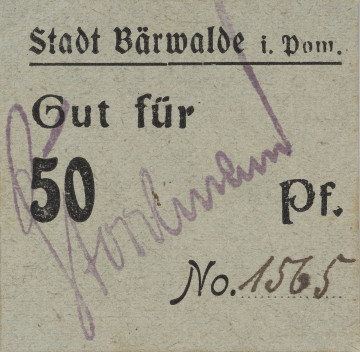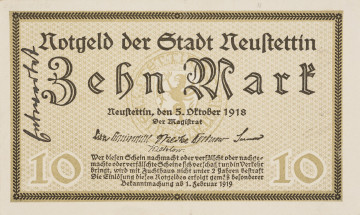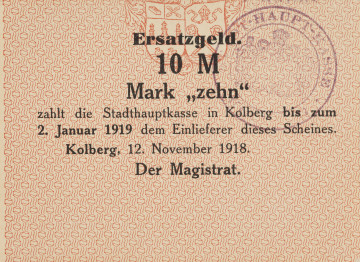
50 pfennigs
1921
National Museum in Szczecin
Part of the collection: Paper money
In substitute money catalogues, bills with a denomination of 1 mark are already called large substitute money (Großnotgeld) and are included in the third period in the history of the German Notgeld (1918–1921), characterized by the greatest demand for bills of 5, 10, and 20 marks. However, issuers also introduced bills in denominations of 1, 2 and even 50 and 100 marks. The issuance of substitute money was seen as a source of cheap credit and additional funds for current expenses, even though it caused inflation. Moreover, local administrations used large amounts of substitute money to meet the demand of the dynamically developing collectors' market, generating additional revenue in the coffers of the municipalities. The authorities of Nörenberg, now Ińsk, also joined this trend. By issuing the presented, graphically unsophisticated 1-mark bill, they continued the trend started in the years 1916–1922, in the period of small money (Kleingeldscheine), by issuing a denomination of 50 pfennigs, also with collectors in mind. Bills of the type presented were probably printed almost exclusively for the needs of collectors. This is evidenced by the frame surrounding the 1 mark denomination, known in eleven varieties differing only in the details of the bends, and the multitude of colours of individual versions: light brown, dark and light orange. Only the first, brown version, printed on plain paper and with a handwritten signature, is considered a circulation edition. Orange cardboard bills with an ink facsimile of the signature are collector's editions. To create even more attractive varieties for collectors, the bills were authenticated with four different seals: the city hall, the municipal savings bank, the city seal and occasionally the treasury and tax chamber. The same procedure was followed in the case of bills worth 5 and 10 marks. Mieszko Pawłowski
Other names
Eine mark, Notgeld, Grossnotgeld
Object type
voucher
Technique
flat printing
Material
cardboard
Origin / acquisition method
purchase
Creation time / dating
Creation / finding place
Owner
Muzeum Narodowe w Szczecinie
Identification number
Location / status

1921
National Museum in Szczecin

1918
National Museum in Szczecin

1918
National Museum in Szczecin
DISCOVER this TOPIC
Museum of King Jan III's Palace at Wilanów
DISCOVER this PATH
Educational path